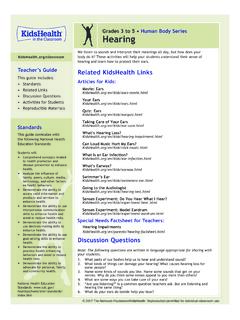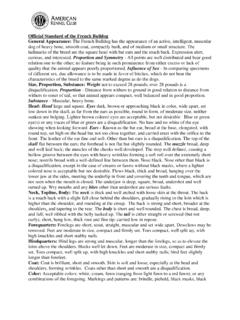Transcription of Blocked Ears Wax Self-Care Guidelines for Patients
1 Blocked ears (wax). Self-Care Guidelines for Patients Issued by Northumbria Healthcare NHS Foundation Trust 1. What is earwax? Earwax is a natural secretion which forms a protective coating on the skin in the ear canal. The quantity of earwax produced varies greatly from person to person. If you think you have a build-up of earwax, do NOT try to clean the ear canal with cotton wool buds. This can make things worse, as you will push some ear wax deeper inside. It may also cause an ear infection. A doctor or nurse can look into the ear canal and confirm a plug of earwax has formed. A plug of earwax is not a serious problem, more a nuisance. You only need to remove earwax if wax build-up is causing symptoms such as dulled hearing or problems with a hearing aid. How to remove earwax Ear drops Earwax usually falls out on its own. If it doesn't and blocks your ear, put two or three drops of ordinary olive oil into the ear two or three times a day for two to three weeks.
2 This softens the wax so that it comes out of its own accord without harming the ear. You will not necessarily see wax come out. It often seems to come out unnoticed. If you are prone to repeated wax build-up you can continue to use olive oil drops twice a week to prevent recurrence. You can continue for any length of time, but three weeks is usually enough. If olive oil does not work you can buy sodium bicarbonate drops from pharmacies. 2. Step-by-step guide to administering ear drops Warm the drops to room temperature before using them Lie on your side with the affected ear facing up when putting in drops Gently pull and push your outer ear to work the drops in Stay lying down for 10 minutes to allow the drops to soak into the earwax. Bulb syringing In most cases ear drops will clear a plug of earwax. However if this is unsuccessful a bulb syringe may be an alternative way to clear your ears from wax.
3 An ear bulb syringe is a small bulb shaped rubber object which can be filled with water and then used to squirt the water gently into the ear to remove earwax. The main benefit of the bulb syringe is that you can use it yourself without needing to make an appointment with your practice nurse or GP. The risks of using a bulb syringe include ear infection, failure to remove the wax and eardrum perforation. These risks are low. Bulb syringes can be purchased from a pharmacy and can be re- used. Please be aware that you should not share the syringe with other people for hygiene reasons. 3. When should a bulb syringe not be used? Do not use a bulb syringe in the following circumstances: Pain in the ear A history of eardrum perforation in the affected ear A recent history of an ear infection in the affected ear Symptoms of infection in the ear usually pain or smelly discharge If you only have one hearing ear which is the affected ear Previous ear surgery on the affected ear In the above circumstances please make an appointment to see your practice nurse or GP to have your ears examined and appropriately treated.
4 4. Step-by-step guide to using a bulb syringe It is essential to use olive oil drops twice a day for at least 14 days prior to bulb syringing to soften the wax. Alternatively you can purchase ear drops from your pharmacy (please read the manufacturer's leaflet.). Wash your hands Use a bowl of clean warm (not hot) water, that is warm to the touch, but not too hot or too cold on your skin Prepare the syringe by squirting it in the water a few times to fill it up with warm water Gently pull your outer ear up and out to help straighten out the canal and allow better access for the water Tilt your head so the ear to be treated is facing upwards Place the tip of the syringe into the opening of the ear Do NOT. push the syringe further into the ear - and GENTLY squirt one or more bulb syringes of water into your ear. (You can do this in the shower or the bath or lie on the bed with a towel underneath your head to catch the water).
5 Allow the water to remain in your ear for at least 60 seconds Gently tilt your head in the opposite direction and wiggle the outer ear to help the water and wax come out. (This can be done over the sink). If you experience any pain during or before this procedure stop immediately and see your practice nurse or GP for a review. If, after three weeks or more, you are still deaf from wax, you will need to make an appointment with a doctor or nurse to decide what should be done. 5. Ear irrigation (ear syringing). Ear irrigation is only recommended in the rare occasions where ear drops and bulb syringing has failed to work. Ear syringing can lead to ear infections, perforated ear drum and tinnitus (persistent noise) and therefore it is only performed in exceptional circumstances. If you think you have persisting wax despite taking the above measures please make an appointment with your doctor or nurse to discuss.
6 Who to contact If you have any questions about your treatment please contact your community nursing team. How to contact your community nursing team In Northumberland, you can contact your community nursing team via your GP surgery. In North Tyneside you can contact your community nursing team via the Single Point of Access on: 0191 238 0044. If you need the services of a community nurse outside normal working hours please call 01670 536 400 for Northumberland and 01670 828 674 for North Tyneside. 6. Notes and questions 7. Alternative Formats If you would like a copy of this information in large print, another language, audio tape or other format please call the Contact Centre on 03 44 811 8118. Other sources of information NHS 111. NHS Choices NICE (National Institute for Health and Clinical Excellence). Patient Advice and Liaison Service (PALS).
7 Freephone: 0800 032 0202. Text: 01670 511098. Email: Northumbria Healthcare NHS Foundation Trust General Enquiries 03 44 811 8111. PIN 800/V1. Review date: October 2021. This material is the copyright of the Northumbria Healthcare NHS Foundation Trust. 8.










